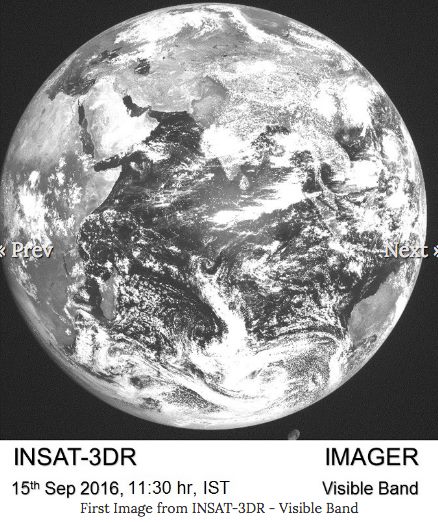Indian Space Research Organisation on Thursday revealed the first picture clicked from INSAT-3DR, an advanced meteorological satellite launched recently on September 8. The weather satellite was launched into a Geostationary Transfer Orbit, at an altitude of 36,000km above Earth. The weight of the satellite is 2,211 kg and the length of the GSLV-F05 rocket stands tall at 49 meters. The satellite was launched from ISRO’s second launch pad at Satish Dhawan Space Centre, Sriharikota.

Earth’s disk with moon in the background – Image Source: ISRO
The INSAT-3DR has been configured with an imaging system and an atmospheric sounder, and it was launched with GSLV-F05 powered by an indigenous cryogenic engine. The rocket then pushed the satellite in the geostationary transfer orbit.
The satellite’s multi-spectral imager can capture good quality images of the Earth’s disc from the altitude of 36,000 kilometer once every 26 minutes. It even provides information of several key parameters like radiation, cloud motion, precipitation, snow cover, sea surface temperature etc. It is able to capture images in six wavelength bands.
Like INSAT-3D, INSAT-3DR too is equipped with a Data Relay Transponder along with a Search and Rescue Transponder. This way INSAT-3DR will continue to offer service to ISRO’s previous meteorological missions and expand further the ability to offer various meteorological as well as search and rescue services.
Subscribe To Indian Nerve
Indian Space Research Organisation on Thursday revealed the first picture clicked from INSAT-3DR, an advanced meteorological satellite launched recently on September 8. The weather satellite was launched into a Geostationary Transfer Orbit, at an altitude of 36,000km above Earth. The weight of the satellite is 2,211 kg and the length of the GSLV-F05 rocket stands tall at 49 meters. The satellite was launched from ISRO’s second launch pad at Satish Dhawan Space Centre, Sriharikota.
Earth’s disk with moon in the background – Image Source: ISRO
The INSAT-3DR has been configured with an imaging system and an atmospheric sounder, and it was launched with GSLV-F05 powered by an indigenous cryogenic engine. The rocket then pushed the satellite in the geostationary transfer orbit.
The satellite’s multi-spectral imager can capture good quality images of the Earth’s disc from the altitude of 36,000 kilometer once every 26 minutes. It even provides information of several key parameters like radiation, cloud motion, precipitation, snow cover, sea surface temperature etc. It is able to capture images in six wavelength bands.
Like INSAT-3D, INSAT-3DR too is equipped with a Data Relay Transponder along with a Search and Rescue Transponder. This way INSAT-3DR will continue to offer service to ISRO’s previous meteorological missions and expand further the ability to offer various meteorological as well as search and rescue services.